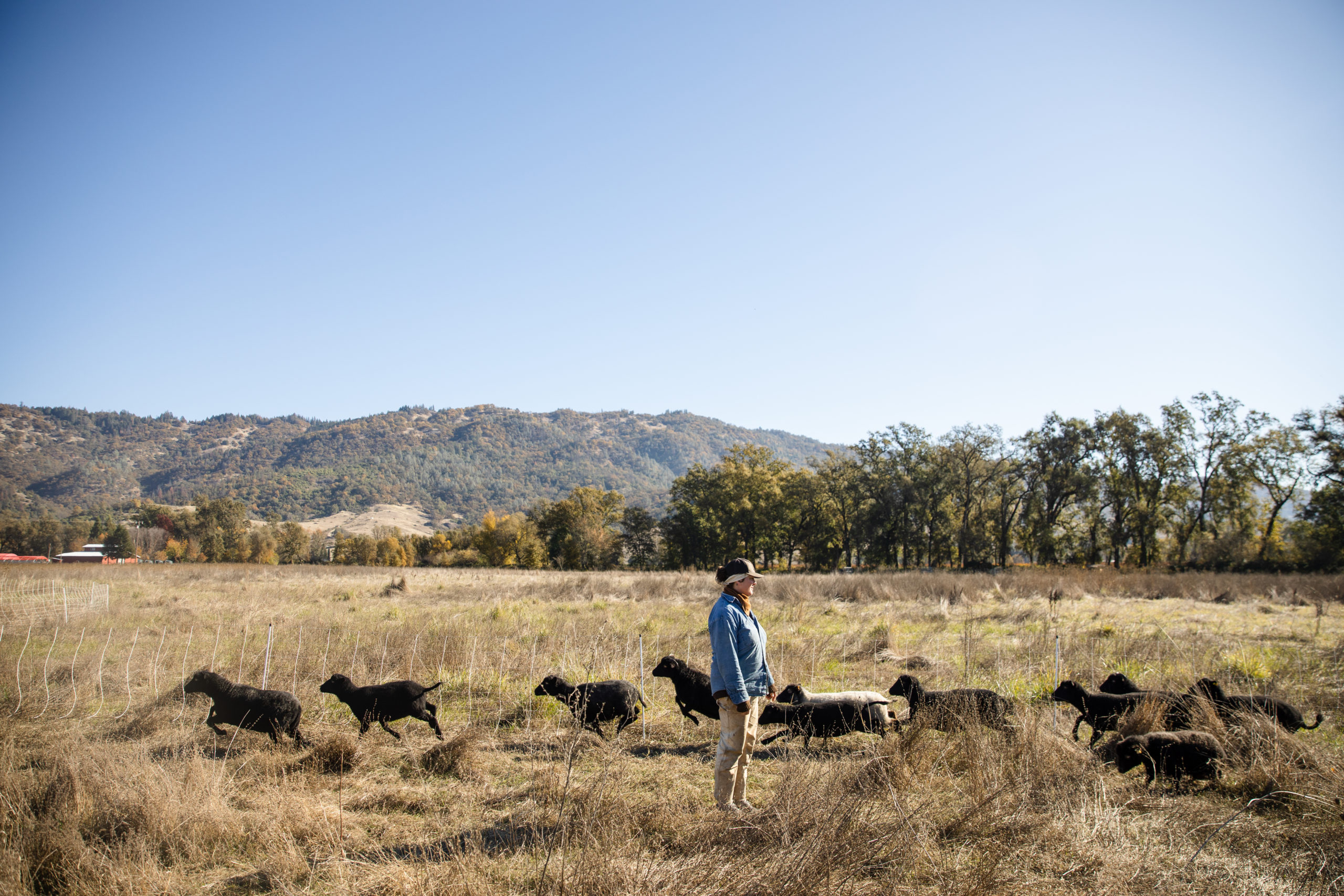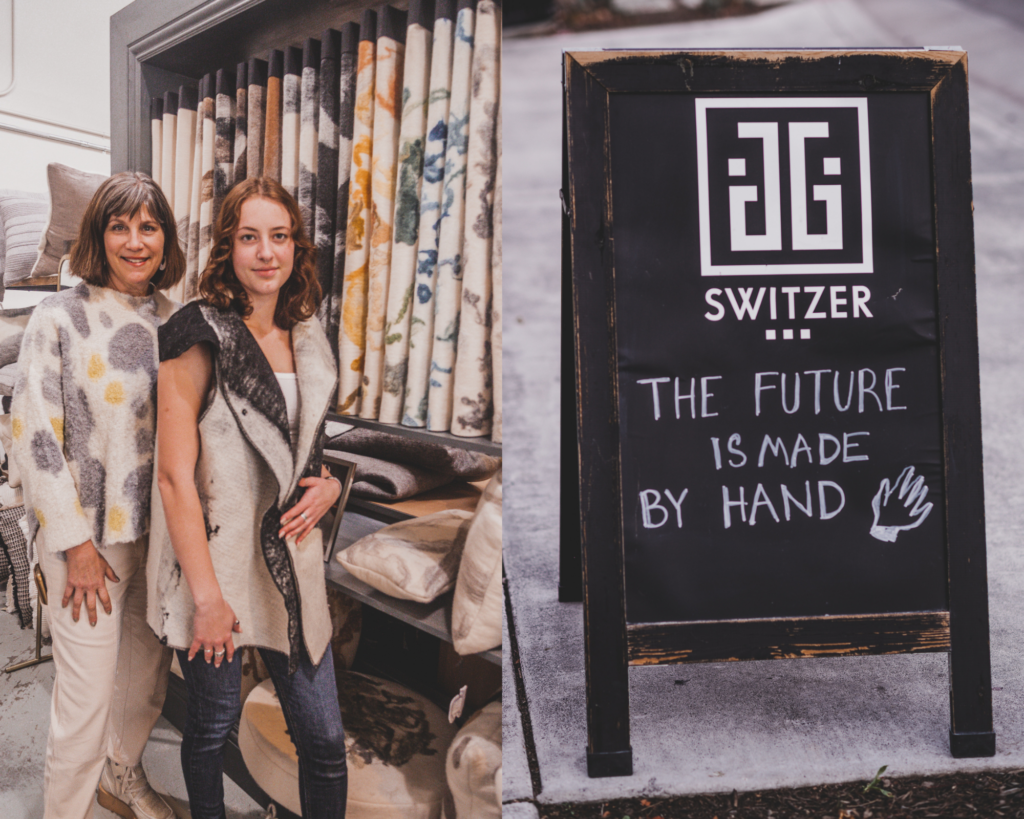
At Fibershed, we are inspired every day by the designers in our network who are creating textiles from natural fibers grown on our regional landscapes.
The six designers featured below are incredibly mindful in their approach to textile design, all while elevating what it means to use local, land-based materials. A few of the practices that set them apart include sourcing regional organic cotton and wool from Climate Beneficial™ ranches, made-to-order and small-scale production, and considering how clothing can make us feel throughout our lifespan.
Continue reading to learn more about these designers and small brands, all members of Fibershed’s Producer Network, and how they prioritize the soil-to-soil model through their design choices.
A Love of Design: Kosa Arts
Written by Marie Hoff and photographed by Hubbard Jones

Designer Elaine Hamblin lives at the threshold between land and garment. With a desire to relate more deeply to her natural landscape, Elaine’s love of design transforms materials from her local fibershed into useful, functional garments that take care of the wearer, the worker, and the planet.
Elaine is the founder of KOSA Arts, a concept shop showcasing KOSA Brand Apparel and artisan goods. The venture blends Elaine’s interests in clothing and interior design, producing apparel in small-batch quantities with great attention to sourcing, construction, and design. Continue reading to learn more.
Herderin Begins with the Body and Soul
Written by Stephany Wilkes and photographed by Paige Green Photography

For Alix Vasquez, the creator behind Herderin, garments begin with the body and soul, not the clothing itself. Alix says: “What if garment consideration began with asking: Where would you like to be held? Where would you like to have some more support? … Could a garment play a role in healing you? Could it feel like wearing a parent’s clothes? What can clothing do for us, emotionally?”
Herderin is a clothing atelier based in San Rafael, California. Alix recently started working with Climate Beneficial™ Wool and wants to source fabric from as close as possible. She says: “The fabric is the same as food. It’s about sourcing, supporting locals I’ve come to know, using the beautiful harvest, and letting the best ingredients speak for themselves. How much closer can I get? Sense of place is really important to my work.” Read more about Herderin here.
Choreographing Change with Marie Hoff of Full Circle Wool
Written by Sasha Wirth and photographed by Paige Green Photography

Supporting healthy land management at her 2.5-acre homestead in inland Mendocino County is a priority for Marie Hoff. This mindset epitomizes her values and how she runs her business, Full Circle Wool – a wool goods and grazing company.
“It was a conscious decision from the beginning that Full Circle Wool would create a two-fold return,” Marie says. “First, it would support local farmers and their land by buying their wool at a rate that was profitable to them. Then, it would give back a percentage of sales towards implementing new Climate Beneficial practices. We’d be supporting the land management of today while simultaneously investing in tomorrow.”
Continue reading to learn more about Marie and how she’s caring for her flock, supporting her community, growing her Climate Beneficial home goods business, and healing the land.
Grange Home Returns the Hand to the Made
Written by Stephany Wilkes and photographed by Paige Green Photography

Beth Miles is an established part of the Fibershed community, having brought producers’ goods to viable markets for years. But she is, above all, an incredible craftsperson and artist. Beth’s industrial design, art, and apparel design and construction skills meet as she works leather, fabrics, and hardscapes; paints, designs, and sews. She is the creator behind her Grange Home line, which is a culmination of — and departure from — her prior life in apparel design. Beth applies the best of what she’s learned and leaves the rest behind.
Grange Home utilizes Climate Beneficial™ Wool, which is verified by Fibershed and sourced from land stewards who are enhancing carbon drawdown through agricultural practices that regenerate soil health. Continue reading to learn more.
A Handmade, Zero-Waste Wardrobe for Mother and Child by Gynna Made
Written by Sasha Wirth and photographed by Hubbard M Jones

Everything from the materials used to the manufacturing process is sustainable at Gynna Made, a clothing and home goods line by Gynna Clemes. Each piece of clothing is made-to-order, essentially creating zero waste. Scraps are used for stuffing or mending or are composted. All designs go through a rigorous six-month wear-and-test period.
Gynna says: “I know who grew the fabric. I can lean into every step and every stitch of creation. For some people, that sense of grounding is walking barefoot in the grass. I connect through using my hands, putting love and attention into each garment.” Learn more about Gynna, her process, and her business here.
JG SWITZER Shares the Magic and Magnificence of Wool
Written and photographed by Koa Kalish

JG SWITZER’s vision is to become a design studio known for natural fibers and felted wool and elevate the wool into the notoriety it deserves. “The home goods and design trade audiences are really in need of — and some people are very hungry for — a fabric they can use in their home,” says Jessica Green Switzer, the brand’s founder. “There simply aren’t many natural fiber offerings.”
JG SWITZER offers clean, shorn, raw wool that is 100% compostable and natural. The brand uses this yardage for various products, including wall art, upholstered furniture, pillows, pet products, laptop cases, sponges, throws, bedcovers, and fabricated headboards, chairs, and ottomans.
Jessica says: “I love the rediscovery of nature’s genius. Wool is a miracle fiber. Humans have been using it, wearing it, and utilizing it as a major source of survival for a thousand years or more. There’s no reason to stop now.” Read more about JG SWITZER here.
Learn more and get involved
Join the design challenge | Are you a textile designer based in Northern or Central California? Join our ‘Borrowed from the Soil’ Design Challenge! This year-long challenge is an opportunity for textile designers in Northern and Central California to explore a new soil-to-soil vision for the future of our material culture. We hope this Design Challenge will encourage you to explore beyond the product, connecting your process and products with the farmers, the people, and the land in our region, while also looking at how your design choices can embed longevity, compostability, and respect for the soil.
Explore resources for textile designers | If you are a textile designer based outside of Northern or Central California, you can still access our resources for designers! Explore the resource page for information on sourcing regional textiles and dyes, designing for healthy and resilient ecosystems and communities, and more.
Explore our producer directory | The Fibershed Producer Program is a membership-based network of farmers, ranchers, designers, sewers, weavers, knitters, felters, spinners, mill owners, and natural dyers living and working within 51 counties in the North and Central regions of California. Explore our Producer Directory to learn more about these producers and how you can support their work and source soil-to-soil fiber and goods.
